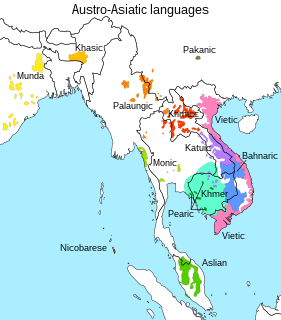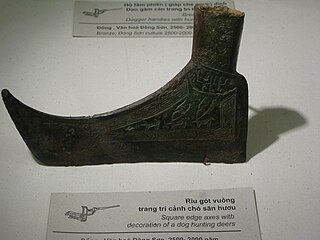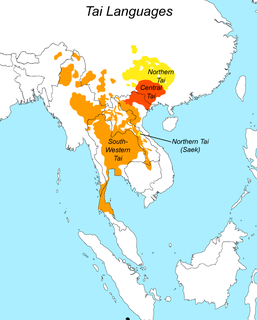Related Research Articles

The Vietic languages are a branch of the Austroasiatic language family, spoken by the Vietic peoples in Laos and Vietnam. The branch was once referred to by the terms Việt–Mường, Annamese–Muong, and Vietnamuong; the term Vietic was proposed by La Vaughn Hayes, who proposed to redefine Việt–Mường as referring to a sub-branch of Vietic containing only Vietnamese and Mường.
The Thổ ethnic group inhabits the mountainous regions of northern Vietnam, mainly Nghệ An Province southwest of Hanoi. Many Thổ speak the Tho language, which is closely related to Vietnamese. The Thổ population numbered 91,430 in 2019.

The Dong Son culture or the Lạc Việt culture was a Bronze Age culture in ancient Vietnam centred at the Red River Valley of northern Vietnam from 1000 BC until the first century AD. Vietnamese historians attribute the culture to the states of Văn Lang and Âu Lạc. Its influence spread to other parts of Southeast Asia, including Maritime Southeast Asia, from about 1000 BC to 1 BC.
The Kaleun people are an ethnic group of Thailand and Laos.
Nakai-Nam Theun National Park in Nakai District, Khammouane Province, Laos, is one of the last remaining wildernesses in Southeast Asia. Nakai-Nam Theun covers approximately 4,270 km2 of the Annamite Range and the adjacent Nakai Plateau in Khammouane and Bolikhamsai Provinces. It was designated a national park on 15 February 2019 by Prime Ministerial Decree No. 36, 15 February 2019. It is managed by the Ministry of Agriculture and Forestry (MAF). It is adjacent to the Vu Quang National Park of Vietnam.

Nguồn is a Vietic language spoken by the Nguồn people in the Trường Sơn mountains in Vietnam's North Central Coast region as well as in nearby regions of Laos.
Thavưng or Aheu is a language spoken by the Phon Sung people in Laos and Thailand. There are thought to be some 1,770 speakers in Laos, largely concentrated in Khamkeut District. A further 750 speakers live in 3 villages of Song Dao District, Sakon Nakhon Province, Thailand, namely Ban Nong Waeng, Ban Nong Charoen, and Ban Nong Muang.
Akha is the language spoken by the Akha people of southern China, eastern Burma, northern Laos, and northern Thailand.
The Arem language is an endangered language spoken in a small area on either side of the Laos–Vietnam border. It is an Austro-Asiatic language that is a member of the Vietic language family. Specifically, it is a member of the Chut language group, which is one of the six Vietic languages. This language is considered severely endangered by UNESCO. Like other Vietic languages, the Arem language makes use of a tonal or phonational system that is unique to Vietic languages. Like many southern Vietic Languages, the Arem language also makes use of pre-syllables or sesquisyllables within the language.
Maleng, also known as Pakatan and Bo, is a Vietic language of Laos and Vietnam.
Chứt or Rục-Sách is a dialect cluster spoken by the Chứt people of Vietnam, with a smaller population of some 450 speakers in neighbouring Khammouane Province, Laos. It is a Vietic language that may be most closely related to Arem.

Tai people refers to the population of descendants of speakers of a common Tai language, including sub-populations that no longer speak a Tai language. There are a total of about 93 million people of Tai ancestry worldwide, with the largest ethnic groups being Dai, Thais, Isan, Tai Yai, Lao, Ahom, and Northern Thai peoples.
Tai Yo, also known as Tai Mène and Nyaw, is a Tai language of Southeast Asia. It is closely related to Tai Pao of Vietnam, where it may have originated. It was once written in a unique script, the Tai Yo script, but that is no longer in use. The language is known regionally in Laos and Thailand as Tai Mène and Tai Nyaw and, in Vietnam as Tai Do and Tai Quy Chau. Superficially, Tai Yo appears to be a Southwestern Tai language but this is only because of centuries of language contact and it is properly classified with the Northern Tai languages. The Nyaw/Nyo spoken in central Thailand and western Cambodia is not the same as Tai Yo.
The Mày language is an small Chuet language spoken in Minh Hóa district, Quảng Bình province, Central Vietnam by the May. It is a member of the Chuet languages, a Southeast Vietic subgroup of the Austroasiatic family.
Khongsat, also called Suma, is a Loloish language of northern Laos.
The Sách is a Vietic ethnic group of Vietnam, native people of the mountains of Central Vietnamese province of Quảng Bình. The exonym Sách might had originated from 15th century encounter and Sino-Vietnamese name for "register," which pre-modern Vietnamese texts used the term to designate villages that inhabited by various Austronesian and Austroasiatic highlanders, while according to Michel Ferlus, the name's meaning may have relation with uncertain ancient Chinese terminologies. In Vietnam, they are considered a sub-ethnic group of the Chứt.
Phong or Tày Poọng is a Vietic dialect cluster spoken in north-central Vietnam. Varieties include Đan Lai, Toum, and Liha.
Vietic peoples refers to a group of ethnic groups of Southeast Asia.
The Thémarou is a tiny and little known Vietic ethnic group of Laos, indigenous of the Nakai-Nam Theun National Park. Themarou people live in upper Nam Theun River. Their current population is 47. Like many Vietic type I groups, the Themarou are in very endangered and critical lifehoods, caused by the effect of NT2 Project's relocation program for indigenous peoples.
The Arem is a small, unreached, and endangered Vietic ethnic group of Vietnam and Lao PDR, native people of the mountains of Central Vietnamese province of Quảng Bình and neighboring Khammouan province of Laos. Their alternate autonyms are Umo, Chmbrau or Chmrau. In Vietnam, they are considered a sub-ethnic group of the Chứt.
References
- ↑ Sidwell, Paul; Jenny, Mathias, eds. (2021). The Languages and Linguistics of Mainland Southeast Asia: A Comprehensive Guide. De Gruyter. p. 197. ISBN 978-3-11055-814-2.
- ↑ Chamberlain, James R. (2018). A Kri-Mol (Vietic) Bestiary: Prolegomena to the Study of Ethnozoology in the Northern Annamites . Kyoto Working Papers on Area Studies No. 133. Kyoto: Kyoto University.
- ↑ Schliesinger, Joachim (2003). Ethnic groups of Laos, Vol. 1 Introduction and overview. White Lotus Press. p. 173. ISBN 978-9-744-80036-7.